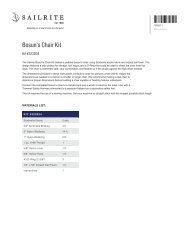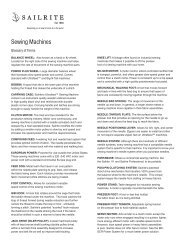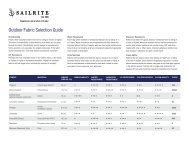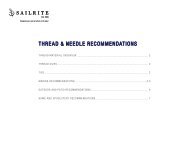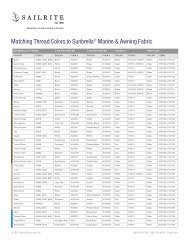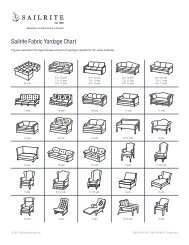Binder Installation
Binder Attachment Instructions (PDF) - Sailrite
Binder Attachment Instructions (PDF) - Sailrite
You also want an ePaper? Increase the reach of your titles
YUMPU automatically turns print PDFs into web optimized ePapers that Google loves.
<strong>Binder</strong> <strong>Installation</strong><br />
Stationary & Swing <strong>Binder</strong>s<br />
#100102, #100103, #100104,<br />
#100105, #102582<br />
103550*1<br />
Watch video tutorials on installing &<br />
using your Sailrite binder at Sailrite.com
A<br />
feeder mouth<br />
A<br />
B<br />
C<br />
D<br />
feeder ledge<br />
binder slot<br />
screws & washer<br />
B<br />
#100104<br />
3/4"<br />
F<br />
D<br />
#100105<br />
1"<br />
C<br />
Installing a Stationary <strong>Binder</strong><br />
G<br />
1. Attach the binder to the sewing machine by inserting the two screws (each<br />
with a washer) D through the binder slot C into the two holes in the bed of<br />
the machine F. Angle the binder slightly toward the presser foot to better<br />
feed the binding under the foot. Screw placement in the binder slot will vary<br />
from machine to machine.<br />
H<br />
2. Position the narrow end of the binder G as close as possible to the foot<br />
assembly without touching the foot or the feed dog using the two screws<br />
next to the feeder mouth A. Typically, the narrow end of the feeder mouth is<br />
right at the front edge of the needle plate slot opening H. The binder should<br />
not come into contact with the foot or feed dog when sewing.<br />
3. If using an Ultrafeed LSZ-1, set the needle position lever in the “Right”<br />
position.<br />
4. J Feed proper-sized binding into the wide end of the feeder mouth and use<br />
a screwdriver blade to pull the binding completely through the slot. Sew off<br />
a small portion of binding to test stitch position.<br />
J<br />
If presser foot rubs against feeder ledge B to get the correct stitch position,<br />
remove the feeder ledge with a dremel tool or hack saw.<br />
5. K Insert the raw fabric edge that needs binding into the crease of the<br />
binding as it exits the binder mouth. Feed the material tightly into the crease<br />
of the binding and sew for a perfectly finished edge.<br />
K
3/4"<br />
1"<br />
#100103 #100102<br />
E<br />
A<br />
B<br />
A<br />
B<br />
C<br />
D<br />
E<br />
feeder mouth<br />
feeder ledge<br />
binder slot<br />
screws & washer<br />
thumb screw<br />
D<br />
F<br />
C<br />
Installing a Swing <strong>Binder</strong><br />
1. Attach the binder to the sewing machine by inserting the two screws with<br />
the washer D through the binder slot C (not the 3 holes above the slot) into<br />
the two holes in the bed of the machine F. Screw placement in the binder<br />
slot will vary from machine to machine.<br />
G<br />
2. Adjust the feeder mouth A from left to right using the large thumb screw<br />
E and from front to back using the two screws next to the feeder mouth.<br />
Position the binder as close as possible to the foot assembly without<br />
touching the foot or the feed dog G. Typically, the narrow end of the feeder<br />
mouth is right at the front edge of the needle plate slot opening H. The<br />
binder should not come into contact with the foot or the feed dog when<br />
sewing.<br />
H<br />
3. If using an Ultrafeed LSZ-1, set the needle position lever in the “Right”<br />
position.<br />
4. J Feed proper-sized binding into the wide end of the feeder mouth and use<br />
a screwdriver blade to pull the binding completely through the slot. Sew off<br />
a small portion of binding to test stitch position.<br />
If presser foot rubs against feeder ledge B to get the correct stitch position,<br />
remove the feeder ledge with a dremel tool or hack saw.<br />
J<br />
5. K Insert the raw fabric edge that needs binding into the crease of the<br />
binding as it exits the feeder mouth. Feed the material tightly into the crease<br />
of the binding and sew for a perfectly finished edge.<br />
K
E<br />
A<br />
B<br />
C<br />
D<br />
E<br />
feeder mouth<br />
feeder ledge<br />
binder slot<br />
screws & washer<br />
thumb screw<br />
A<br />
F<br />
B<br />
D<br />
C<br />
G<br />
Installing a 2" Swing <strong>Binder</strong> #102582<br />
1. Attach the binder to the sewing machine by inserting the two screws with<br />
the washer D through the binder slot C (not the 3 holes above the slot) into<br />
the two holes in the bed of the machine. Screw placement in the binder slot<br />
will vary from machine to machine.<br />
2. Adjust the feeder mouth A from front to back using the two screws next to<br />
the feeder mouth. Position the binder as close as possible to the front of<br />
the presser foot without touching the foot or feed dog F. The binder should<br />
not come into contact with the foot or the feed dog when sewing. Adjust the<br />
stitch position close to the inside edge of the binding by moving the feeder<br />
mouth from left to right using the large thumb screw E.<br />
3. G Feed proper-sized binding into the wide end of the feeder mouth and use<br />
a screwdriver blade to pull the binding completely through the slot. Sew off<br />
a small portion of binding to test stitch position.<br />
H<br />
4. Insert the raw fabric edge that needs binding into the crease of the binding<br />
as it exits the feeder mouth. Feed the material tightly into the crease of the<br />
binding and sew for a perfectly finished edge.<br />
TIP: For lighter fabrics like Dacron tape, hold your finger in front of the binder to<br />
help keep the fabric from creeping H.



